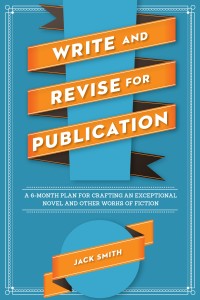Guest Post by Jack Smith
I tend to like fiction that can be read on several different levels. It’s not just a good story; it also points to abstract ideas of various kinds—to themes beyond the literal level of character and plot. Perhaps it suggests something about the nature of evil, about personal identity, or about the nature of freedom. How heavy should the machinery of idea be? Naturally, this depends on what your purpose is and who your audience is. I won’t take that question on here, but I will say that there are several thematic techniques that can work seamlessly with story. You don’t have to trowel on ideas like icing on the cake.
What are these techniques? I’ll deal with three.
- Repetition. When a given word, thing or place, or action is repeated several times, it can begin to mean more than what it would mean if it occurred just once. For instance, if the story has to do with freedom from different types of oppressive situations or environments, and if the word “cramped” is used in several different contexts, the reader may get an existential sense for the various ways humans can be cramped. Perhaps your character feels cramped in her small house; perhaps her menial job cramps her; perhaps she feels cramped in her marriage. And then perhaps synonyms of the word cramped can be introduced: “hampered,” “hindered,” “impeded.” The cluster of words centered around this idea of being cramped can help illuminate the various kinds of threats to human freedom—and the nature of freedom itself. It’s possible to find ways to thread your story or novel with the ideas suggested by a given key word.
If a particular thing, or place, is mentioned repeatedly, it can also take on meanings beyond its literal existence. For instance, if your protagonist’s house has a view of the mountains, and your protagonist is often at her window looking out at it, this might suggest a desire to break free from life’s ordinary, mundane restraints and embrace the wildness and freedom of nature. What are the various properties of nature that suggest this freedom? The mountain could become symbolic of all the qualities of freedom she seeks, whether she can obtain this kind of freedom or not.
An incident, if it is repeated several times, can also take on larger meanings beyond the literal. If the protagonist’s husband is always leaving the house to go to his high- powered job, and the protagonist feels stuck there with little future ahead of her, then this constant exiting of the husband can take on larger meanings. It might suggest different societal spheres for men and women: the opening of opportunities for men in career fields (as the husband steps outside) and the closing off of opportunities for women (as the door shuts each time on the wife).
- Development of key events with suggestive imagery. Imagine that your protagonist undergoes a sudden illness. If you provide enough suggestive details, you can point to an idea at a more abstract level—perhaps the fragile nature of human existence. Your story isn’t just about this one sick person with this sudden illness; it’s also about human vulnerability period, the tenuous nature of human existence—or rather it can be. Through apt metaphors—comparing the illness to falling in a manhole, having a plane crash on one’s house, being hit by a stray bullet—the reader will begin to see your story at a more general level: how humans can suddenly be struck down with no apparent defense.
- Key passage. Sometimes character thought or reflection can suggest a larger frame of reference, especially if the language is metaphorical. Imagine that your protagonist is a vulture capitalist—already a metaphor. He thinks to himself: “I’m the spider and they’re the fly. It’s a matter of sucking them dry.” With this image and others, one might get at the very essence of vulture capitalism—beyond the surface-level story of the machinations of a particular vulture capitalist.
A work of fiction that takes on multiple meanings is, to me, more interesting than one that has only a character and a storyline. I want to think beyond these to larger implications. A story has to work as a story first, though, with a strong character and an interesting character arc. But look for ways to raise your short story or novel to levels beyond the literal. Don’t force it, but when you see opportunities, take advantage.
Jack Smith is author of the novel Hog to Hog, which won the George Garrett Fiction Prize (Texas Review Press. 2008), and is also the author of Write and Revise for Publication: A 6-Month Plan for Crafting an Exceptional Novel and Other Works of Fiction, published earlier this year by Writer’s Digest. His novel ICON will be published in June by Serving House Books.
Prize (Texas Review Press. 2008), and is also the author of Write and Revise for Publication: A 6-Month Plan for Crafting an Exceptional Novel and Other Works of Fiction, published earlier this year by Writer’s Digest. His novel ICON will be published in June by Serving House Books.
Over the years, Smith’s short stories have appeared in North American Review, Night Train, Texas Review, and Southern Review, to name a few. He has also written some 20 articles for Novel & Short Story Writer’s Market, as well as a dozen or so pieces for The Writer.He has published reviews in numerous literary journals, including Ploughshares, Georgia Review, Missouri Review, Prairie Schooner, American Review, Mid-American Review, and the Iowa Review.
I don’t think I do the layering thing unless it’s by accident.
Elizabeth – Thanks for hosting Jack.
Jack – Thanks for sharing these ways to share themes. And what’s interesting about it is that the author can do that within the context of a story (i.e. not pull the reader out of the actual plot).
If I return to fiction writing, I’d like to try layering more.
I love a story that is layered with theme, plot and much more. I need to work on that more. However, I’ve found that sometimes theme emerges on its own (with my help of course). Thanks, Jack!
Hello, Elizabeth!
Interesting points. I tend to think of theme in terms of more ‘serious’ literature than what I write, but you’ve got me thinking differently! :)
Jack–
You are certainly right about the various ways to bring about thematic development. But the trick is to not draw attention to what’s being done. Otherwise, the reader–at least a smart one–will know he’s being “schooled” in a Big Idea. As a seat-of-the-pants writer, I tend to think theme is part of the DNA of a novel. But from personal experience, I know that in the rewrite process, working to strengthen theme is part of my job.
The best books are the ones that combine a good story with a timeless underlying theme (Dostoyevsky was good at this).
I liked your capitalist metaphor. That’s just the way it is. You should present it to all the working class people who, for unknown reasons, believe that the Republican Party wants to do anything for them >:)
Cold As Heaven
This was a really insightful post! Thanks so much for sharing.
Thanks, everyone! I totally agree: If you layer, it’s got to come out of the character and plot naturally. Don’t force it. Don’t announce themes. But the language is rich with possibilities, and it’s pleasing to see the language at work on several levels.